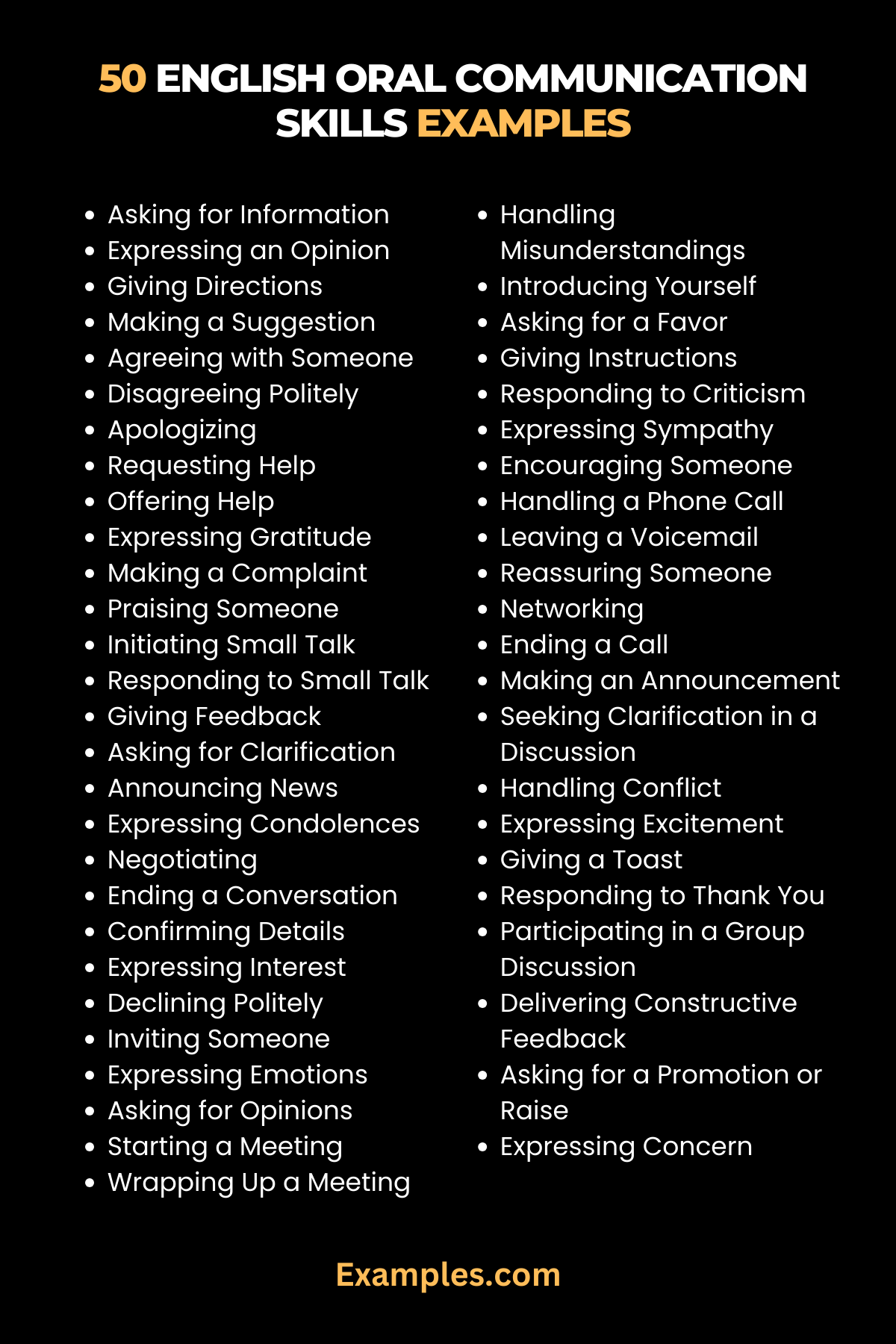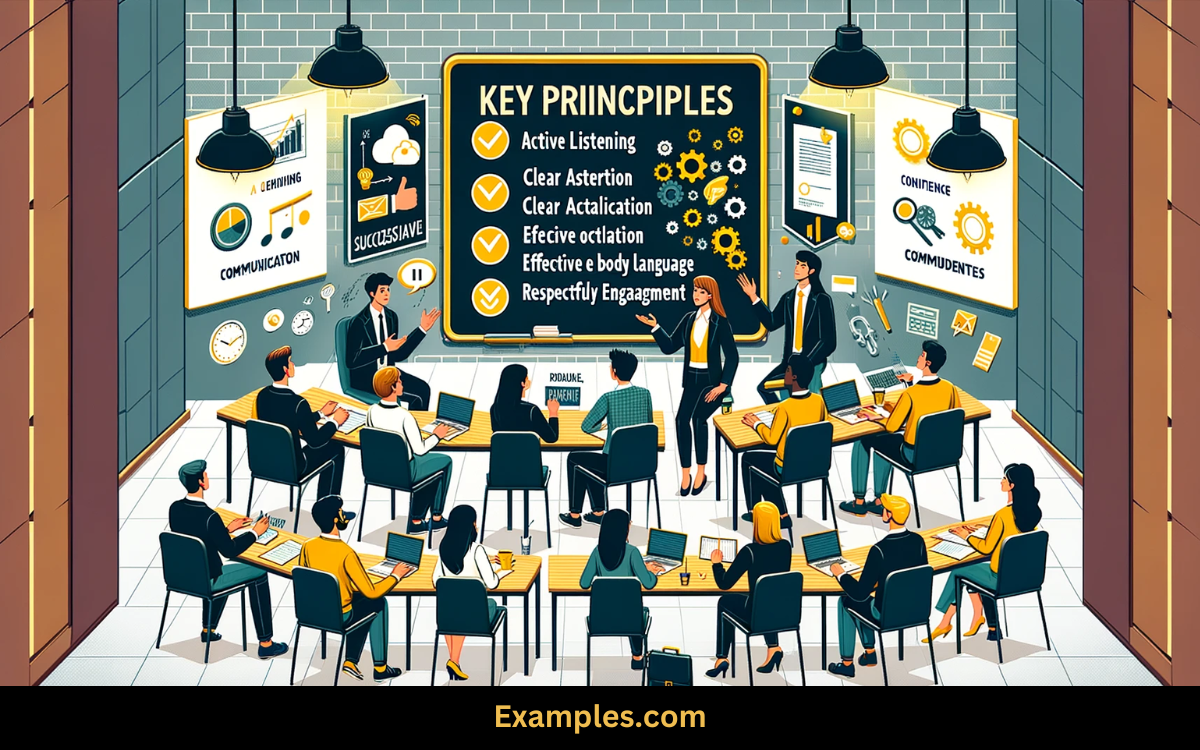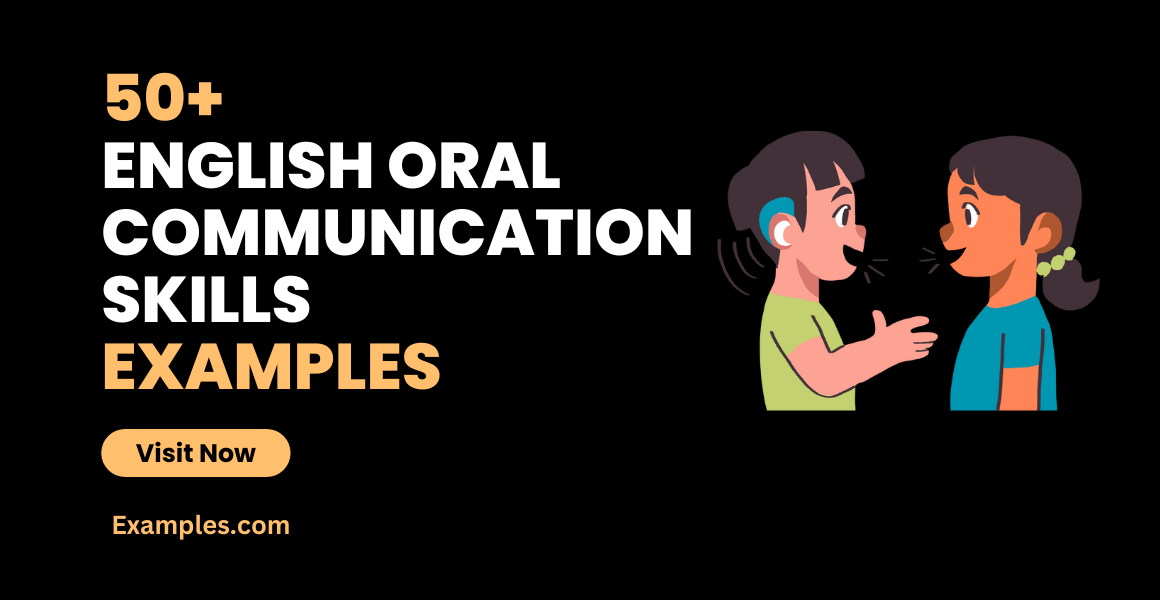English Oral Communication Skills
Mastering English Oral Communication Skills is essential in today’s globalized world. This comprehensive guide, enriched with practical Communication Examples, offers a deep dive into enhancing your verbal skills. From everyday interactions to professional settings, learn the art of effective speaking with sentence examples that illustrate key concepts. Whether you’re a student, professional, or lifelong learner, this guide provides valuable insights to refine your communication skills in English, making every conversation impactful.
50 English Oral Communication Skills Examples
English Oral Communication is a crucial skill in everyday interactions, encompassing everything from casual conversations to professional discussions. This guide provides 50 unique, real-life examples, each accompanied by a brief explanation and communication tip. These examples are designed to enhance various aspects of your oral communication, such as clarity, empathy, assertiveness, and active listening, making your interactions more effective and meaningful. Whether you’re engaging in small talk, negotiating in a business setting, or expressing your thoughts in a meeting, these examples will serve as practical tools to improve your communication skills in English.

Daily Life Oral Communication Examples
- Asking for Information: “Could you please tell me where the nearest coffee shop is?” This is a simple, polite request for information.
How to Communicate: Maintain a friendly tone and direct eye contact. - Expressing an Opinion: “I believe that public transport should be more affordable.” Clearly stating your belief or opinion on a topic.
How to Communicate: Speak confidently and provide reasons for your opinion if necessary. - Giving Directions: “Take a left at the corner, and you’ll see the bank on your right.” Providing clear, concise directions to help someone.
How to Communicate: Use hand gestures if appropriate and speak clearly. - Making a Suggestion: “Shall we try the new Italian restaurant for lunch?” Offering a suggestion in a friendly, inquisitive manner.
How to Communicate: Use an inviting tone to encourage agreement. - Agreeing with Someone: “That’s a great idea, I think it will really work well.” Showing support and agreement with someone’s idea or suggestion.
How to Communicate: Nod in agreement and smile to reinforce your support. - Disagreeing Politely: “I see your point, but have you considered the budget constraints?” Disagreeing without being confrontational, by acknowledging the other person’s view first.
How to Communicate: Use a calm tone and propose an alternative perspective. - Apologizing: “I apologize for the inconvenience caused; we are addressing the issue.” Expressing regret for a mistake or problem.
How to Communicate: Apologize sincerely and offer a solution if possible. - Requesting Help: “Could you help me understand this report better?” Asking for assistance in a respectful manner.
How to Communicate: Be specific about what you need help with. - Offering Help: “Do you need any assistance with your presentation?” Proactively offering help or support to someone.
How to Communicate: Offer help kindly and be ready to assist if accepted. - Expressing Gratitude: “Thank you for your support, I really appreciate it.” Showing appreciation for someone’s help or support.
How to Communicate: Express your thanks warmly and with eye contact. - Making a Complaint: “I’m unhappy with the service; it was much slower than expected.” Expressing dissatisfaction in a direct but respectful manner.
How to Communicate: Keep a calm demeanor and explain the issue factually. - Praising Someone: “You did an excellent job on this project, well done!” Giving positive feedback to acknowledge someone’s effort or success.
How to Communicate: Be enthusiastic and genuine in your praise. - Initiating Small Talk: “Lovely weather today, isn’t it?” Starting a casual conversation on a neutral topic.
How to Communicate: Use a light-hearted tone and open body language. - Responding to Small Talk: “Yes, it’s beautiful! I hope it stays this way.” Engaging in light conversation, showing interest and adding to the topic.
How to Communicate: Respond with a smile and maintain a friendly tone. - Giving Feedback: “Your presentation was very informative, but maybe you could speak a bit louder next time.” Providing constructive criticism in a helpful way.
How to Communicate: Balance positive comments with your suggestions for improvement. - Asking for Clarification: “I didn’t quite catch that last point; could you explain it again?” Seeking more information or a clearer understanding of something said.
How to Communicate: Politely request clarification without implying the speaker was unclear. - Announcing News: “I’m excited to announce that I’ve been promoted to team leader!” Sharing news or an update in an enthusiastic manner.
How to Communicate: Share your excitement and include details that might interest your audience. - Expressing Condolences: “I’m so sorry to hear about your loss; my thoughts are with you.” Showing sympathy and support to someone who is grieving.
How to Communicate: Speak gently and offer your support. - Negotiating: “I understand your price point, but given our budget, can we consider a discount?” Discussing terms in a business or personal context to reach a mutual agreement.
How to Communicate: Be firm yet open to compromise, maintaining a professional tone. - Ending a Conversation: “It was great catching up with you, let’s speak again soon.” Concluding a conversation in a friendly and positive way.
How to Communicate: Smile and express a desire to continue the relationship. - Confirming Details: “Just to confirm, our meeting is scheduled for 3 PM tomorrow, right?” Ensuring clarity and mutual understanding of arrangements.
How to Communicate: Speak clearly and seek acknowledgment to confirm details. - Expressing Interest: “That sounds fascinating. Could you tell me more about it?” Showing genuine curiosity and interest in someone’s statement.
How to Communicate: Lean in slightly and maintain eye contact to show engagement. - Declining Politely: “Thank you for the offer, but I won’t be able to join you this weekend.” Saying no in a courteous and respectful manner.
How to Communicate: Keep your tone gentle and offer a brief explanation if appropriate. - Inviting Someone: “Would you like to join us for dinner on Friday?” Extending an invitation in a friendly and inclusive manner.
How to Communicate: Smile and convey warmth to make the person feel welcome. - Expressing Emotions: “I’m really disappointed with these results.” Openly sharing your feelings about a situation.
How to Communicate: Use a sincere tone and appropriate facial expressions to convey your emotions. - Asking for Opinions: “What do you think about the new marketing strategy?” Seeking someone else’s viewpoint or perspective.
How to Communicate: Show openness and interest in hearing their thoughts. - Starting a Meeting: “Let’s begin by reviewing last week’s progress.” Initiating a meeting with a clear agenda.
How to Communicate: Speak confidently and outline the meeting’s purpose. - Wrapping Up a Meeting: “To summarize, we’ve agreed on the following action points.” Concluding a meeting by reiterating key decisions and next steps.
How to Communicate: Summarize clearly and check for agreement or questions. - Handling Misunderstandings: “I think there’s been a misunderstanding; let me clarify my point.” Addressing and rectifying misunderstandings during a conversation.
How to Communicate: Remain calm and restate your point more clearly. - Introducing Yourself: “Hi, I’m John, the new project manager.” Making a self-introduction in a professional or social setting.
How to Communicate: Offer a firm handshake, if appropriate, and a confident introduction. - Asking for a Favor: “Could you please assist me with this task? I’d really appreciate it.” Requesting help or support in a polite and appreciative manner.
How to Communicate: Express gratitude and be specific about what you need. - Giving Instructions: “Please complete the report by Monday and ensure all data is included.” Providing clear, concise directives or tasks to someone.
How to Communicate: Use a direct but respectful tone, ensuring instructions are understood. - Responding to Criticism: “Thank you for the feedback. I’ll work on those areas.” Accepting criticism gracefully and showing willingness to improve.
How to Communicate: Listen actively, maintain composure, and respond constructively. - Expressing Sympathy: “I’m truly sorry to hear you’re going through this tough time.” Offering words of sympathy and support.
How to Communicate: Speak softly and show genuine concern. - Encouraging Someone: “You’re doing a great job, keep up the good work!” Providing encouragement and positive reinforcement.
How to Communicate: Be enthusiastic and sincere in your praise. - Handling a Phone Call: “Good morning, ABC Company, how can I assist you?” Professionally answering a business call.
How to Communicate: Use a polite, welcoming tone and offer your help. - Leaving a Voicemail: “Hi, this is Jane. I’m calling about our meeting schedule. Please call me back.” Leaving a clear, concise message on someone’s voicemail.
How to Communicate: Speak slowly and leave your contact information. - Reassuring Someone: “Don’t worry, we can definitely solve this issue together.” Offering reassurance and support in a challenging situation.
How to Communicate: Use a calm, confident tone to instill confidence. - Networking: “I’ve heard great things about your work. I’d love to learn more about your projects.” Initiating conversation in a networking setting.
How to Communicate: Show genuine interest and listen actively. - Ending a Call: “Thank you for your time. Let’s speak again soon. Goodbye.” Concluding a phone call in a polite and friendly manner.
How to Communicate: Summarize the call’s key points and end on a positive note. - Making an Announcement: “I’m thrilled to announce the launch of our new product line next month.” Sharing exciting news or updates with an audience.
How to Communicate: Express enthusiasm and highlight key details. - Seeking Clarification in a Discussion: “Could you elaborate on what you mean by that?” Asking for more information or clarity during a conversation.
How to Communicate: Use a curious tone and show that you are engaged in the discussion. - Handling Conflict: “I understand we have different views. Let’s find a solution that works for both of us.” Addressing and resolving disagreements in a constructive manner.
How to Communicate: Stay calm, listen to the other person’s viewpoint, and seek compromise. - Expressing Excitement: “I can’t wait for our team retreat next week! It’s going to be so much fun!” Sharing your enthusiasm about an upcoming event or activity.
How to Communicate: Use an upbeat tone and expressive body language. - Giving a Toast: “Here’s to Sarah and John, wishing them a lifetime of happiness together!” Offering a toast at a social event or celebration.
How to Communicate: Raise your glass, speak clearly, and keep it brief yet heartfelt. - Responding to Thank You: “You’re welcome! I’m glad I could help.” Acknowledging someone’s gratitude.
How to Communicate: Respond warmly and show that you were happy to assist. - Participating in a Group Discussion: “I agree with what’s been said, and I’d like to add a point.” Contributing to a group conversation or meeting.
How to Communicate: Speak clearly and wait for an appropriate moment to join in. - Delivering Constructive Feedback: “Your report was very thorough, but adding more data analysis could enhance it further.” Offering feedback that is both positive and helpful for improvement.
How to Communicate: Balance praise with suggestions for growth. - Asking for a Promotion or Raise: “I believe my recent achievements warrant consideration for a promotion.” Professionally requesting career advancement.
How to Communicate: State your case confidently and provide evidence of your accomplishments. - Expressing Concern: “I’ve noticed you’ve been quiet lately. Is everything okay?” Showing concern for someone’s well-being in a caring manner.
How to Communicate: Speak gently and show genuine care and willingness to listen.
Effective Strategies for Oral Communication in English
Oral communication in English, whether in personal, academic, or professional settings, is an essential skill. This guide focuses on effective strategies to enhance your speaking abilities. Covering aspects from clarity and coherence to empathy and active listening, these strategies are designed to improve your overall communication effectiveness. Each point includes practical examples and explanations on how to implement these techniques, making them invaluable for anyone looking to refine their oral communication skills in English.

Examples and Communication Strategies
- Clarity in Expression: “Let’s focus on one task at a time to ensure efficiency.” Communicating in a clear, straightforward manner avoids confusion.
How to Communicate: Use simple language and avoid jargon. - Active Listening: “I understand that you’re concerned about the deadline. Let’s discuss how we can address this.” Shows you are fully engaged and understand the speaker’s point.
How to Communicate: Nod and provide verbal acknowledgments like “I see.” - Maintaining Eye Contact: “Looking at your audience while speaking builds trust and connection.” Eye contact conveys confidence and sincerity.
How to Communicate: Make eye contact with different members of the audience. - Using Positive Language: “I’m confident we can find a solution to this challenge.” Positive language inspires and motivates listeners.
How to Communicate: Replace negative phrases with optimistic ones. - Effective Pausing: “After making a point… pause briefly… to let it sink in.” Pauses give emphasis to your message and allow the audience to digest information.
How to Communicate: Pause after key statements for impact. - Expressing Empathy: “I understand how this situation might be frustrating for you.” Empathy helps in connecting with the audience on an emotional level.
How to Communicate: Acknowledge others’ feelings and show understanding. - Using Stories and Anecdotes: “Let me share a quick story that illustrates this point.” Stories make your communication more engaging and relatable.
How to Communicate: Use personal or relevant stories to illustrate your points. - Appropriate Humor: “A little humor can lighten the mood and keep the audience engaged.” Humor, when used appropriately, can make your communication more enjoyable.
How to Communicate: Incorporate light, relevant humor without offending. - Asking Questions: “What are your thoughts on this approach?” Questions engage the audience and encourage participation.
How to Communicate: Ask open-ended questions to stimulate discussion. - Summarizing Key Points: “To summarize, our main goals are…” Summarizing helps reinforce your message and ensures clarity.
How to Communicate: Briefly recap the main points at the end of your communication.
Key Principles for Successful English Oral Communication Skills
Successful English Oral Communication Skills hinge on a few fundamental principles that can significantly enhance the effectiveness of your interaction. This guide outlines these key principles, each illustrated with unique examples and explanations. From clarity and conciseness to empathy and active listening, understanding and applying these principles are crucial for anyone looking to improve their oral communication. Whether in a professional, academic, or personal context, these guidelines will help you communicate more effectively and confidently in English.

Examples and Communication Strategies
- Clarity: “I believe we should increase our marketing budget to boost sales.” Expressing ideas clearly without ambiguity.
How to Communicate: Use simple, direct language and avoid jargon. - Conciseness: “Let’s meet tomorrow at 10 AM to discuss the project.” Being brief yet comprehensive in your communication.
How to Communicate: Stick to the point and avoid unnecessary details. - Empathy: “I understand this deadline is challenging for you.” Showing understanding and consideration for others’ feelings.
How to Communicate: Acknowledge the other person’s perspective and respond with kindness. - Active Listening: “So, what you’re saying is we need more time for testing?” Demonstrating that you are fully engaged and understanding the speaker.
How to Communicate: Repeat or paraphrase what was said to confirm understanding. - Confidence: “I am confident our team can handle this project efficiently.” Expressing yourself in a self-assured manner.
How to Communicate: Maintain eye contact and steady voice modulation. - Respectful Tone: “Could we consider your idea in a bit more detail?” Communicating in a way that shows respect to others.
How to Communicate: Use polite language and a calm tone. - Assertiveness: “I firmly believe we need to change our approach here.” Expressing your views firmly and clearly without being aggressive.
How to Communicate: State your opinion confidently while remaining open to others’ ideas. - Body Language: Standing straight, making eye contact when saying, “I’m happy to join the team.” Using non-verbal cues to reinforce your spoken words.
How to Communicate: Ensure your body language matches the message you are conveying. - Adaptability: “Let me explain this in a simpler way.” Adjusting your communication style to suit the audience or situation.
How to Communicate: Be observant and flexible in your approach to communication. - Feedback Seeking: “Do you think this plan will work effectively?” Actively seeking others’ opinions or suggestions.
How to Communicate: Ask open-ended questions to encourage detailed responses.
Types of Oral Communication Skills in English
Oral Communication Skills in English can be categorized into various types, each serving a specific purpose in different contexts. This section highlights the types of oral communication skills, providing distinct examples and guidelines for each. From persuasive speaking to informative communication, understanding these types can help you apply the most appropriate and effective communication technique in various scenarios, enhancing your overall communication ability.

Examples and Communication Strategies
- Informative Speaking: “Today, I’ll explain the new software update process.” Providing clear and factual information to the audience.
How to Communicate: Focus on clarity and avoid personal opinions. - Persuasive Speaking: “Investing in renewable energy is not only beneficial for the environment but also cost-effective.” Convincing the audience to accept a particular viewpoint.
How to Communicate: Use compelling arguments supported by evidence. - Instructive Speaking: “First, open the file, then click on ‘Save As’.” Giving step-by-step instructions to complete a task.
How to Communicate: Be clear and sequential in your instructions. - Narrative Speaking: “Let me tell you about a challenge we overcame last year.” Telling a story to convey a message or entertain.
How to Communicate: Use descriptive language and vary your tone for emphasis. - Descriptive Speaking: “The new design is minimalist, with vibrant colors and an intuitive interface.” Providing detailed descriptions about a situation, object, or event.
How to Communicate: Use vivid language and sensory details. - Demonstrative Speaking: “As I show you this process, notice how the software responds to each command.” Demonstrating how something works while explaining it.
How to Communicate: Coordinate your verbal explanations with physical demonstrations. - Debate: “My opponent argues that this policy will help, but here’s why it won’t…” Engaging in a formal argument or discussion on a specific topic.
How to Communicate: Present clear arguments and rebuttals, backed by facts. - Extemporaneous Speaking: “Given the current market trends, our strategy should focus on digital expansion.” Speaking spontaneously or with minimal preparation.
How to Communicate: Rely on your knowledge and be confident in your delivery. - Motivational Speaking: “You have the potential to achieve remarkable things.” Inspiring and encouraging an audience to take action or make changes.
How to Communicate: Use inspiring stories and a passionate tone. - Ceremonial Speaking: “Today, we gather to honor the achievements of our team.” Speaking at special events, like awards ceremonies or weddings.
How to Communicate: Be formal yet heartfelt, and tailor your message to the occasion.
How to Improve Oral Communication Skills in English
Improving your English Oral Communication Skills is a vital aspect of effective interpersonal interactions, whether in personal or professional settings. Here are strategies to enhance these skills:
1. Practice Regularly
Consistent practice is essential. Engage in everyday conversations, join language learning groups, or find conversation partners. This helps in getting comfortable with speaking English in various contexts.
2. Listen Actively
Immerse yourself in English through various media such as podcasts, movies, or news. This exposure helps in understanding diverse accents and slang, which are integral parts of Listening in Communication Skills.
3. Expand Your Vocabulary
A broader vocabulary allows you to express yourself more clearly and accurately. Use new words in your daily conversation to make them a part of your active vocabulary.
4. Participate in Public Speaking
Engaging in public speaking, through platforms like Toastmasters, can significantly boost your confidence and improve your Communication Skills for Public Speaking.
5. Record and Self-Review
Recording your speech and reviewing it can help identify areas for improvement in pronunciation and fluency, which are crucial for Effective Communication Skills.
6. Seek Constructive Feedback
Getting feedback from peers or mentors is invaluable. Understand your strengths and areas for improvement from an outsider’s perspective.
7. Engage in Role-Playing
Role-playing different scenarios helps in preparing for various real-life communication situations, enhancing your adaptability and responsiveness.
8. Enroll in Communication Skills Training
Professional courses can provide structured learning and expert guidance, helping in a more systematic improvement of your communication abilities.
How to Develop Oral Communication Skills in Students
Developing oral communication skills in students is crucial for their overall academic and social development. Here are effective methods to enhance these skills in an educational setting:
1. Encourage Open Discussions
Create an inclusive classroom environment where students feel comfortable sharing their thoughts. This not only improves their Communication Skills in Classroom but also fosters a sense of community.
2. Implement Interactive Learning Activities
Activities like group discussions, debates, or presentations encourage students to articulate their ideas and listen to others, enhancing their Group Communication Skills.
3. Focus on Individual Feedback
Providing personalized feedback to students can significantly help in improving their speaking abilities, focusing on aspects like clarity, fluency, and Communication Skills Confidence.
4. Use Technology as a Tool
Integrating technology in teaching, like using language learning apps or video recording presentations, can provide students with new and engaging ways to improve their communication skills.
5. Encourage Peer-to-Peer Learning
Peer learning can be very effective, as students often feel more comfortable and less intimidated speaking with their peers. This can improve their Communication Skills for Team interaction.
6. Incorporate Role-Playing in Curriculum
Role-playing exercises can prepare students for various real-world scenarios, enhancing their adaptability and problem-solving skills in communication.
7. Develop Listening Skills
Teaching the importance of active listening is key in developing effective communicators. Activities that focus on listening and understanding are essential.
8. Promote Language Games and Activities
Games and fun activities can make learning enjoyable and less intimidating, especially for younger students, enhancing their Communication Skills for Kids and Teens.
9. Provide Public Speaking Opportunities
Encouraging students to participate in public speaking events can greatly boost their confidence and speaking skills in a more formal and structured environment.
10. Integrate Communication Skills Across the Curriculum
Incorporating communication skills in different subjects and activities ensures that students understand the Importance of Communication Skills in all aspects of their academic and personal lives.
In conclusion, enhancing English oral communication skills is vital for personal and professional success. Regular practice, active listening, expanding vocabulary, and engaging in public speaking are key strategies. For students, fostering an environment that encourages open discussions, interactive learning, and individualized feedback is crucial. By employing these methods, one can significantly improve their proficiency and confidence in English communication.



